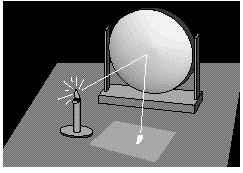Concave makeup mirror
Candle and matches or electric holiday
"candle"
Dark room
Sheet of white paper
Assorted convex lenses
Procedure:
1. Light the candle and darken the room.
2. Bring the concave makeup mirror near the candle flame and tilt and turn it so that reflected light from the candle flame focuses on a sheet of white paper.
3. Experiment with different lenses to find one suitable for turning the makeup mirror into a simple reflector telescope. Hold the lens near your eye and move it until the reflected light from the mirror comes into focus.
Discussion:
Many reflecting telescopes gather light from distant objects with a large parabolic mirror that directs the light toward a secondary mirror which then focuses the light onto a detector. The concave mirror used in this demonstration shows how a concave mirror can concentrate light to form a recognizable image. The image produced with a makeup mirror is not well focused because the mirror is inexpensively produced from molded glass rather than from carefully shaped and polished glass.
The light gathering power of a telescope goes up with the area of the lens or mirror used as the primary light collector. (See Light Gathering Power activity on page 56.) The

bigger the telescope lens or mirror, the more light and the fainter the object the astronomer can collect. Small telescopes can only detect bright stars. Large telescopes (over 4 meters in diameter) can detect objects several billion times fainter than the brightest stars.
Large astronomical telescopes do not use eyepieces. Light falls on photographic film, photometers, or CCDs. This demonstration shows how an image forms on a flat surface. Covering the surface with photographic film will produce a crude picture. Although astronomers have converted to CCDs for most observations, photography is still employed for some applications. Rather than film, astronomers usually prefer photographic emulsions on sheets of glass, which are more stable over time.
For Further Research:
- Why are the largest astronomical telescopes made with big objective mirrors rather than big objective lenses?
- Find out how different kinds of reflecting telescopes such as the Newtonian, Cassegranian, and Coude work.
